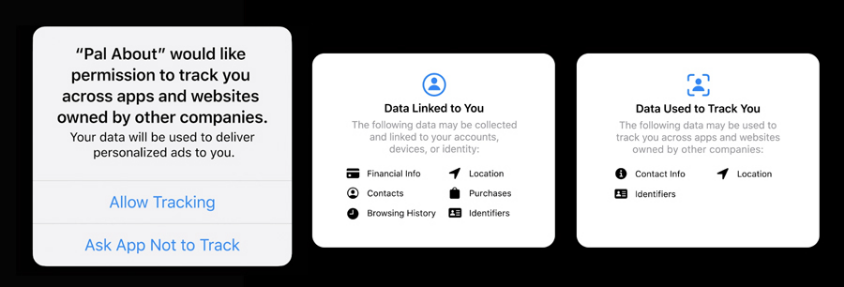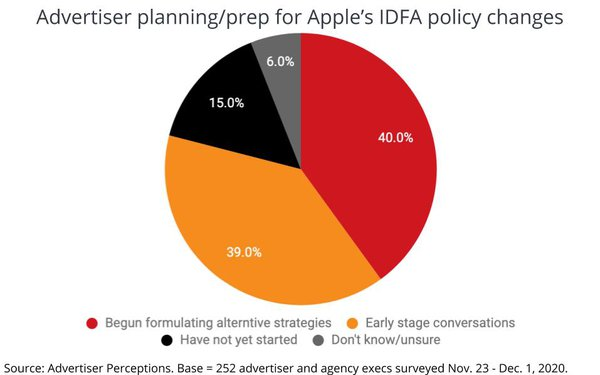
Apple is making massive changes to the settings on iPhones, all in the name of privacy.
This move will fundamentally change mobile advertising on those devices by taking a privacy option, which up until now was hidden deep in users’ phones, and displaying it prominently when they open an app.
This is expected to dramatically impact the way advertisers target ads and a lot of companies are scrambling to figure out how best to move forward without breaking the new rules and getting kicked out of the Apple App Store.
If you have questions about this seismic change that is rocking the ecosystem, and why it’s so important to mobile growth marketers, read the rest of this article to discover what you need to know to understand how IDFA will impact the future of advertising.
We’ll start with the basics.
What is IDFA?
IDFA stands for Identifier for Advertisers. It’s a unique tracking system that assigns a random ID number to each iOS device.
It is used for tracking user activity (such as monitoring the ads that they interact with) and works in much the same way that browser cookies do when tracking online activity.
But, unlike browser cookies that are limited to only tracking browser activity, IDFA allows advertisers to monitor user activity on non-browser apps.
This allows advertisers to gain useful data on activity that happens outside of browsers, including mobile app installs, in-app ad interactions, and much more.
When Were IDFA Changes Announced?
The new IDFA changes were announced in June last year and planned as a feature in the newest version of Apple’s operating system, iOS 14.
They will fundamentally alter the way apps work to track user data in order to develop targeted ads.
When Will IDFA Changes Take Place?
The changes were supposed to launch late last year but were delayed to offer app makers additional time for retooling their ad systems to comply.
These radical changes are set to go into effect in early Spring of 2021, and businesses should start feeling the impact within the first half of 2021.
However, although the date is still TBD, it doesn’t mean that advertisers can relax.
Industry players that don’t want to be behind the ball once this launches must use this time to ensure that their apps and methods are compliant.
How is Apple Changing IDFAs and Why?
Tracking via IDFA was on by default before iOS 14. Users still had the option to opt-out and prevent advertisers from tracking their device, but they actually had to go in and change the settings in order to do so.
Now, by default, IDFA tracking will be turned off, which means users now have to explicitly tap the option to “Allow Tracking” in order to enable it.
The notification will look something like this:

App creators can customize the message, albeit in a limited way.
In essence, Apple is dredging a privacy option from the depth of users’ phones and putting it front and center so it’s hard to miss when they open an app.
iPhone users will be presented with a pop-up window in every app which notifies users that the app will track their data for advertising purposes.
It also gives them the option of blocking the app from doing that.
The obvious fear among app developers is that a lot of users will simply switch off the ad tracking feature of an app whenever they see that pop-up warning.
This, in turn, will destroy their business model which allows advertisers to effectively target iPhone ads and measure their effectiveness.
Why Is Apple Making These Changes at All?
Apple cites its reasoning for the IDFA update as wanting to ensure users have additional transparency into how they are being tracked and targeted while using iOS devices and apps.
The goal is to create an improved user experience that continues their focus on protecting user privacy.
The company isn’t out to “get” mobile marketers, and it hasn’t deprecated IDFA.
The tracking system still exists and some users will have it enabled on their devices.
But, according to industry experts, the problem is that “some users” means only about 5% - at best.
In fact, Facebook already warned that this change could reduce publishers’ audience network revenue by up to 50%.
Below are some of the ways this new change will impact advertisers.
Impact of IDFA Update on Advertisers
Getting users to opt in to share their IDFA for apps to track them will likely result in lower opt-in rates.
According to one marketer, users would have to be insane for them to opt into personalization and tracking offered by advertisers considering how Apple implements the pop-up warnings.
That’s why a lot of companies are doing their best to figure out ways to communicate to their users how valuable the opt-in is for the business (although it’s important to note that Apple has already stated that many of those methods won’t fly).
For the same reason outlined above, advertisers will have a lot less definitive data to glean insights from.
In terms of measuring ads, the measurement and fraud capabilities of most Mobile Measurement Partners (MMPs) are built based on the IDSA identifier.
Apple’s solution for digital advertisers who need to be able to use data in order to make money through apps is to give them access to its SKAdNetwork.
Although this replacement API will allow conversion data to be transmitted back at the campaign level, it won’t provide the same granular level of data that advertisers were receiving before, which is why not many are keen on this as an alternative solution.
A lot of targeting types will no longer work once users opt out of sharing their IDFA (for example, retargeting users based on device-level targeting).
This won’t be such a big problem for platforms like Facebook and Google that have many other deterministic variables (e.g. phone number, email, etc.) for identifying devices.
However, many other programmatic platforms without this type of deterministic ID graph data will likely see a massive reduction in their targetable audiences and may have to utilize environmental scanning to determine how impactful it can be to their core business model.
Ultimately, this will lead to advertisers looking for innovative methods for identifying users.
Keep in mind that some of those new methods for determining user identity or devices to target may not be in compliance with the new rules.
For instance:
This means that other methods utilizing signals from a user’s phone as a way to analyze or measure that are not strictly “fingerprinting”, may fall into the gray area.
How Do People Feel About This Move?
A lot of people have criticized the IDFA change, stating that it is likely to hurt the small independent players in the ecosystem.
The major theme among people in the ad industry is the fear concerning the potential impact on businesses that offer free apps supported by ads.
Although many consumers are annoyed by ads, it doesn’t mean they are willing to shell out money in order to use every app they need - and if that’s the case, are those apps going to survive?
Facebook, in particular, has stated that these changes are designed to take the free, ad-supported internet and transform it into paid services and apps, where Apple will be able to get its 30% cut while crushing the ability of small businesses to do personalized advertising.
In short, Apple has taken away most of the opportunities for third-party ad monetization while failing to offer a viable replacement for marketers and publishers.
And although the SKAdNetwork might help somewhat in mitigating the issue, it’s not a scalable response as it has so many limited aspects.
What Happens to Businesses That Don’t Comply?
The company has stated that tech players who track without permission or violate any of Apple’s new guidelines will face the removal of their apps from the app store.
As of yet, it hasn’t been made clear exactly how the company would detect or discover their behavior.
But, beginning in 2021, all apps will be taken down that track user activity in a way that can be shared with other companies without first receiving permission from that user.
This lack of information on how Apple intends to police those methods leaves the window open for companies trying to find workarounds to face pushback or consequences from Apple.
How is the Industry Adapting?
There is still very little or no understanding of Apple’s new IDFA rules.
According to MediaPost, by December 2020, over 40% of businesses had already begun formulating alternative strategies.

However, a lot of businesses in the mobile ad ecosystem feel that Apple did not give them clear guidance or communication.
With ad tech companies saying one thing and Apple saying another, it has muddied people’s understanding of what they can and cannot do.
As they struggle to retool their apps to ensure compliance, many are choosing to err well on the side of caution.
Now that you know what these new changes may mean for the future, the question is, what can you do about it?
That’s the question most people are asking themselves, and in the absence of clear instructions from Apple, many in the ad tech industry have simply run away with insane fantasies for ways to sidestep this.
However, it’s important to take the right steps to avoid incurring penalties from Apple.
Luckily, there are certain things that app developers and the companies that help them make money through ads can do to ensure the safety of their business in the future, such as:
These are just a few of the ways you can future-proof your apps and turn the IDFA update into an opportunity.
Of course, the main factor in helping you keep your app and business safe in light of these changes is to prioritize your user experience design and customer experience strategy.
It was already five times more expensive to get new customers in a world with unrestricted IDFA tracking, and now it’s even more important for businesses to shift their marketing strategies so they focus more on customer engagement as opposed to customer acquisition.
This includes things like:
…and much more.
A lot of companies are investing more heavily in the area of contextual targeting, which means that they will target the environment the user is in, as opposed to targeting the actual user.
For instance, they might determine whether one app’s audience would generally have an interest in downloading another app.
As an example, if a company like Grubhub knows that an individual has downloaded the Entrepreneuer.com app, they may try to recruit them as a GrubHub driver.
The reason? Grubhub allows everyday individuals a chance to work for themselves, so it’s a market fit for the outcome they desire, which is to recruit new drivers.
Other players are looking for ways to target factors such as network connection strength, user’s battery level, and so on in an effort to get information on an individual’s device to target without actually connecting to the identity of the user specifically.
Suffice it to say that there are a myriad of ways companies will try in order to preserve their businesses and apps in the future.
What’s Next for Advertisers?
Hopefully, by now you understand what IDFA is, how it’s changing the future of advertising, as well as how the industry is adapting.
The bottom line is, IDFA hasn’t taken personal data away entirely.
App publishers can still draw on extremely valuable first-party data that gives advertisers confidence by weaving consent workflows into user touchpoints instead of depending on consent signals.
Granted, these new changes still hold tons of intricacies and unanswered questions for app publishers in the post-IDFA world.
So use this article as your resource to help you prepare for the IDFA changes in a proactive way and avoid the severe consequences that come with failing to comply with the new rules.
To learn more about the data behind this article and what Pathmatics has to offer, visit www.pathmatics.com.







Sign up to receive our stories in your inbox.
Data is changing the speed of business. Investors, Corporations, and Governments are buying new, differentiated data to gain visibility make better decisions. Don't fall behind. Let us help.













Sign up to receive our stories in your inbox.
Data is changing the speed of business. Investors, Corporations, and Governments are buying new, differentiated data to gain visibility make better decisions. Don't fall behind. Let us help.





